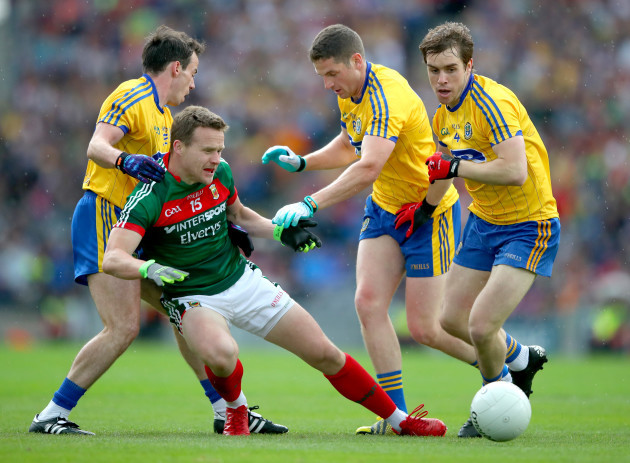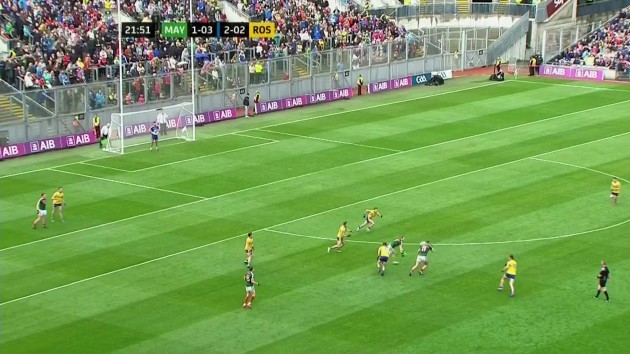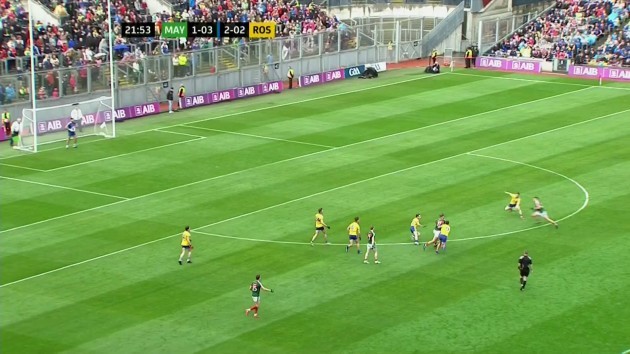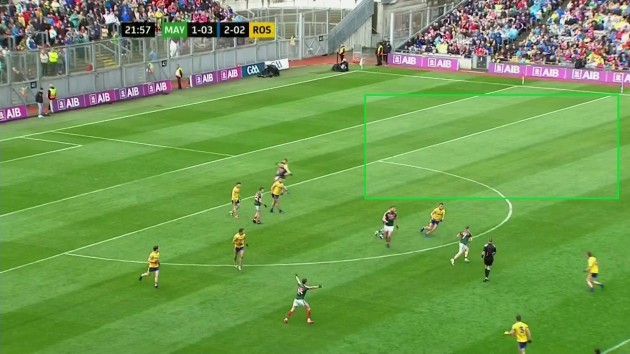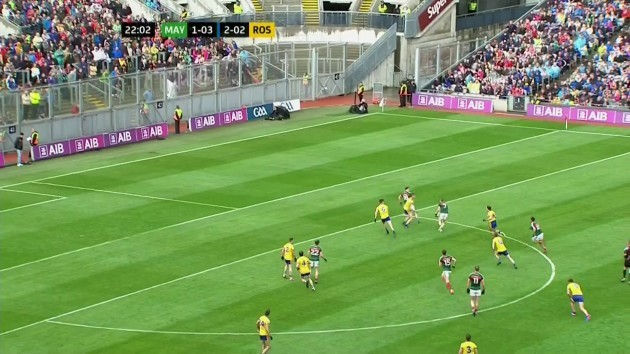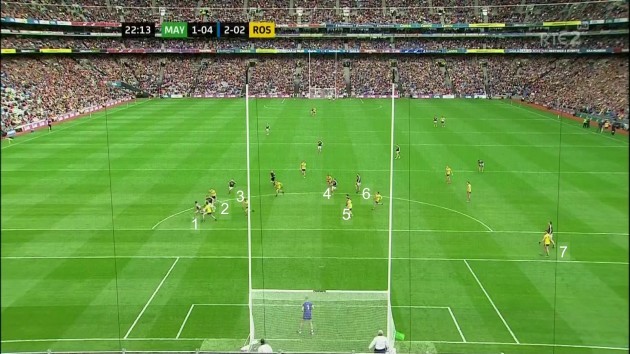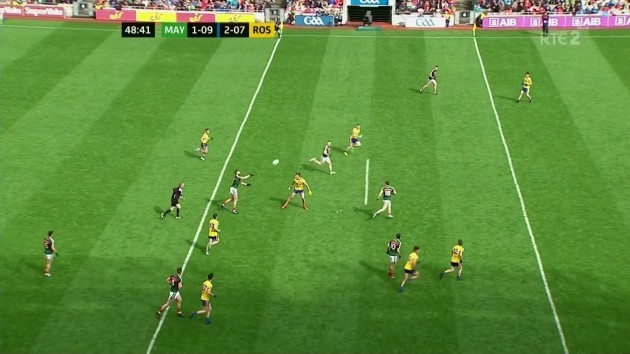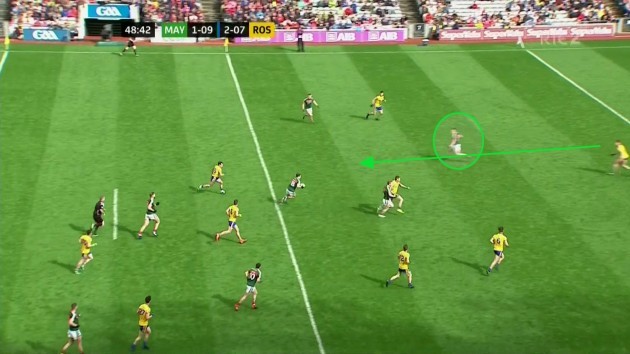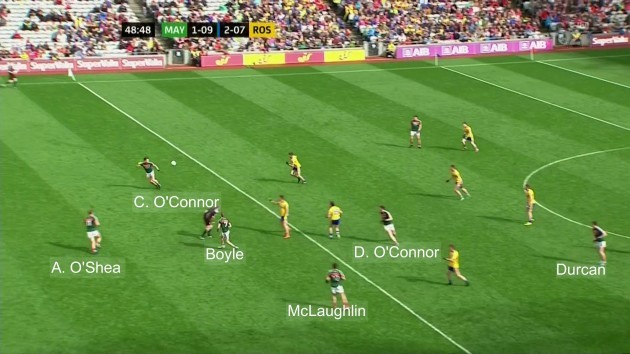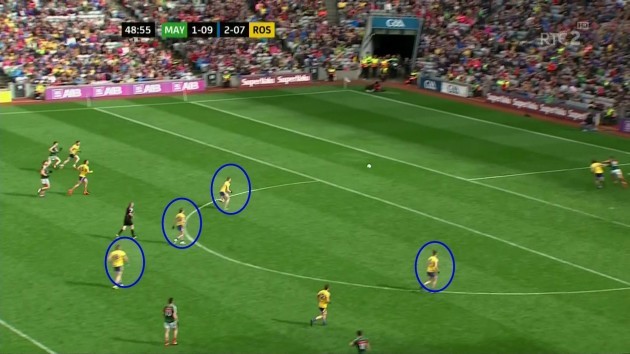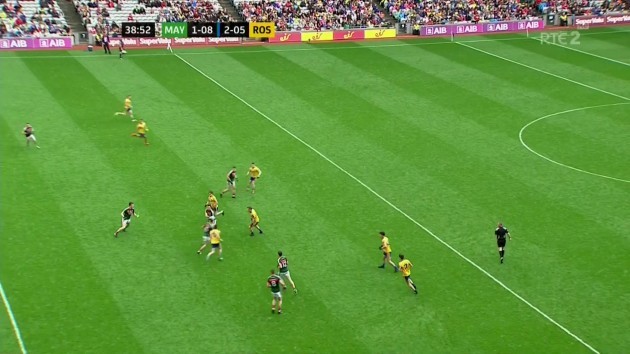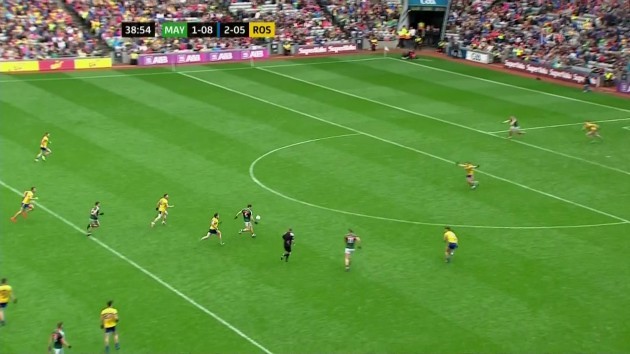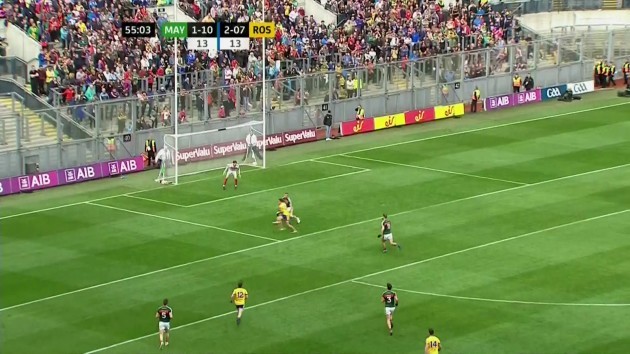IN THEIR SIX matches so far this season, Mayo have managed to win only two in normal time. They show all the signs of a team that have given everything and are just about hanging on by their fingertips.
All the heart and endeavour this team has shown over the last few years was on full display yesterday. Unfortunately it just feels like the skill execution has waned.
In saying all that, this team are the team that just keep giving. Dublin and Kerry go about their business with a ruthless efficiency, that at times offers little entertainment. Not Mayo, whatever they do it seems to come with drama.
Mayo’s narrow attack
Mayo have some of the strongest runners in the game but everything they do is straight down the middle.
Yesterday’s game saw 56 turnovers. The conditions played a part in that but both teams kicked easy ball away and ran into a lot of tackles.
We pick up an example in the first half where Colm Boyle lays off to Aidan O’Shea in the first half just outside the Roscommon D.
Roscommon had Niall Kilroy at sweeper for most of the game so the space is closed pretty quickly.
Jason Doherty arrives off the shoulder but O’Shea is under pressure and can’t get the pass off.
Next up is Kevin McLoughlin who arrives at pace.
Neither of these runs are bad, but where is the variety. McLaughlin is again looking to run straight down the heart of the Roscommon defence.
O’Shea turns and lays the ball back to Boyle. Moran is calling for it but he is well marshalled and is unlikely to get a shot off if he does get the ball.
As Doherty and McLoughlin have made their runs, there is a huge amount of space wide but nobody from Mayo is wide.
Even if someone just stood there, it forces Roscommon to make a decision to mark or not.
Boyle is forced to take on a man twice, and to be fair does it really well and ends up kicking a score but if we look at this attack from behind the goal we can see how narrow Mayo are.
Seven players are all effectively in the D. They got the score on this occasion but this won’t work all the time as was proved by the number of turnovers on Sunday.
In the second half we see the same attacking style. O’Shea picks the break up from a long kickout. Roscommon have at least seven players behind the ball at this stage – so it’s a chance for a good attack.
As he plays the ball forward both Boyle and Paddy Durcan run the exact same line.
Durcan picks the ball up and Cillian O’Connor decides to come out and join the conjested middle third.
Mayo hardly need more bodies in the centre of the pitch. If needed to come out on the loop, then it needed to be later in the move not to the Roscommon ’65.
Cillian O’Connor get the ball a few seconds later but the majority of Mayo’s attacking unit you could throw a blanket over. Nobody is hugging a touchline or asking any questions of the Roscommon sweeper.
Cillian plays a low ball to Andy Moran but it’s a difficult ball to win and Roscommon have plenty of bodies to put the pressure on.
Even when Mayo could find a little bit of space, Niall Kilroy was always on hand at the back.
In this move Mayo again get all bunched in the middle with Cillian O’Connor joining them.
There are six players within touching distance. Chris Barrett offers the run this time and manages to get through.
It’s an excellent run and exactly what you want to see but having just one forward inside makes life easier for the sweeper.
What if O’Connor stays inside and Moran and O’Connor are either side of the D. Suddenly as Barrett breaks through he’s got a new set of problems.
Instead Kilroy knows everything is running straight at him and Moran is directly behind him. Even Aidan O’Shea’s run is towards Barrett rather than trying to keep whatever width is there.
Andy Moran gets the ball in heavy traffic, is forced to turn and shoot and who gets the block in? Kilroy!
In this case Kilroy was able to act as cover and stop the onrushing Barrett and when the pass was laid off be close enough to get the block on Moran. It’s excellent defending but Mayo have made it easier than it should be.
Mayo have powerful runners and it’s obvious to see why they want to use that strength as much as possible, but they need to give them more room to run into.
Whether that comes from playing O’Connor closer to goal or asking the wing-forwards to keep wide is a matter for debate but Mayo won’t get away with just trying to run down the middle.
Lee Keegan v Enda Smith
Putting Lee Keegan on Enda Smith was a really key tactical battle and Stephen Rochford deserves a lot of credit for that and likewise McStay for the switch at half-time. It will be really interesting to see how they play each other next Monday in the replay.
When McStay put Smith in at full forward, Keegan followed him for about the first 15 minutes of the second half but then started to venture forwards.
Enda Smyth probably played the pass of the game after Keegan had left him.
Flicking the ball up onto his foot Mayo look well set, but he plays a lovely ball over O’Shea and Higgins.
It shows how good a player he is and will make the managerial decision of where to play him that bit more interesting.
Mayo took eight of the last 10 shots in the game but only managed two scores. They could feel aggrieved about the free they gave away for the Roscommon equalizer but with the chances they had to win it at the end, they only have themselves to blame.
Tyrone played 10 games to win the All Ireland in 2005. If Mayo want to lift Sam in 2017 they will be required to play at least nine.
A case for the numbers
In the Monaghan Down game and the Mayo Roscommon game there is a strong case where numbers (‘stats’) could add to the analysis.
Numbers shouldn’t take over the half-time talk but both of these games offered a good example of where they could be very informative.
Mayo from play in the first half yesterday had a shot conversion ratio of 58%. On its’ own this is simply a number and we could compare it to Roscommon whose first half was 36%.
But here is the thing. Shot percentage is a relatively stable number across seasons. Of course you have games where it is high and games where it is low, but in general it tends to be very similar across seasons.
In order to put the 58% in some sort of context we need to know what Mayo normally do. Their average across the entire 2016 season from play was 44%.
Rather than just using the 58% as an indication of Mayo’s ‘great’ shooting, we can frame it that Mayo have over-performed given their usual standard. All things being equal we would expect them to shoot closer to their average of 44%. Mayo’s second half shooting was in fact 31% (4/13) meaning their full game average was 44%.
There was a very similar scenario in the Down and Monaghan game. A draw game at half time, with a lot of praise for how Down had performed.
But Down had over-performed and Monaghan under-performed against their averages. Of course individual games can take on a life of their own and nothing is guaranteed but both teams moved closer to their average which meant Monaghan came out on top.
It won’t always be this precise of course but it can help the debate.
The42 Podcasts / SoundCloud
